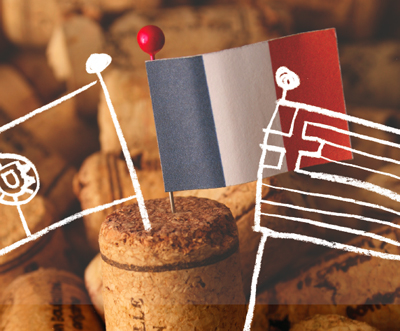 Walking into an LCBO outlet is like entering the General Assembly of the United Nations. Wines from every continent stand arranged like aisles of orderly diplomats, with the name of each country announced in bright, consular lettering: Canada! Chile! Germany! Even China! It’s enough international togetherness to make a man break out into Esperanto. Vivu diverseco!
Walking into an LCBO outlet is like entering the General Assembly of the United Nations. Wines from every continent stand arranged like aisles of orderly diplomats, with the name of each country announced in bright, consular lettering: Canada! Chile! Germany! Even China! It’s enough international togetherness to make a man break out into Esperanto. Vivu diverseco!
Unfortunately, this is all a tissue of lies. Behind the happy pretense of diversity, the world of wine is hopelessly enslaved to one master, whose preference is the law and whose image is an idol. Who is this despot, this taskmaster? Who else? The villainous French.
France has an iron grip on wine. French grapes have colonized every major wine growing country and French tastes have infected every market. Cabernet Sauvignon, Merlot, Pinot Noir and Chardonnay make the most prestigious bottles and all are originally French grapes. Even so-called New World grapes (like Shiraz in Australia or Malbec in Argentina) arise from France. We live (or at least drink) a monoculture.
It does not have to be this way. The world is teeming with undiscovered gems. There are between five and ten thousand types of Vitis vinifera, which is the species of vine that produces top quality wine. Many of these varieties are known only to isolated corners of Europe, where they have evolved to suit the local microclimate. Some varieties have a slightly higher profile, at least in their country of origin.
However, no matter how popular Touriga Nacional is in Portugal, or Xinomavro is in Greece, these grapes labour in obscurity here in North America. It is not flavour that disadvantages them, but the simple fact that they have unfamiliar names.
Canada is supposed to be a country of diversity. Prove it by experimenting with a grape you’ve never tried before. After all, we stopped being New France a long time ago.
Into the Short Cellar
![]() Tilia 2009 Torrontes
Tilia 2009 Torrontes
$12.95, Argentina, LCBO #186403
Torrontes, Argentina’s most planted white grape, creates an inexpensive but deliciously perfumed wine with a perfect balance between fruit and acidity. The Tilia is an especially fine specimen — it features a rich, creamy mouth-feel and lots of tropical flavours. Drink young. 89/100
![]() Crasto 2010 Vinho Tinto
Crasto 2010 Vinho Tinto
$14.95, Portugal, Vintages Essentials #81588
Quinta do Crasto is a leading producer in the Douro region of Portugal, an area earning a reputation for its affordable dry reds. Crasto’s Vinho Tinto is a mix of several grapes, including the indigenous Touriga Nacional, and has a plush and plumy texture. 88/10
Gimme some new grapes
if you’re looking to broaden your horizons and try some grapes off the beaten path, here are the Short Cellar top picks:
- Grüner Veltliner: On a recent trip to New York, I noticed many fashionable restaurants had this white Austrian grape in heavy rotation. It’s bracing like Riesling, with a fuller body and a spicy bite.
- Nero d’Avola: This Sicilian variety can make a pro- found and age-worthy red. Although it is light in body and elegant, it contains scads of deep, alluring flavours like mocha, smoke and wild plum.
- Albariño: Grown in Spain, this grape makes a dry white rich in floral and aromatic flavours. It is as refreshing as any light white wine, but carries with it remark- able complexity and grace
Matthew Sullivan is a civil litigator in Toronto. Email matthew@lawandstyle.beta-site.ca
Image: fotografiabasica/istockphoto

